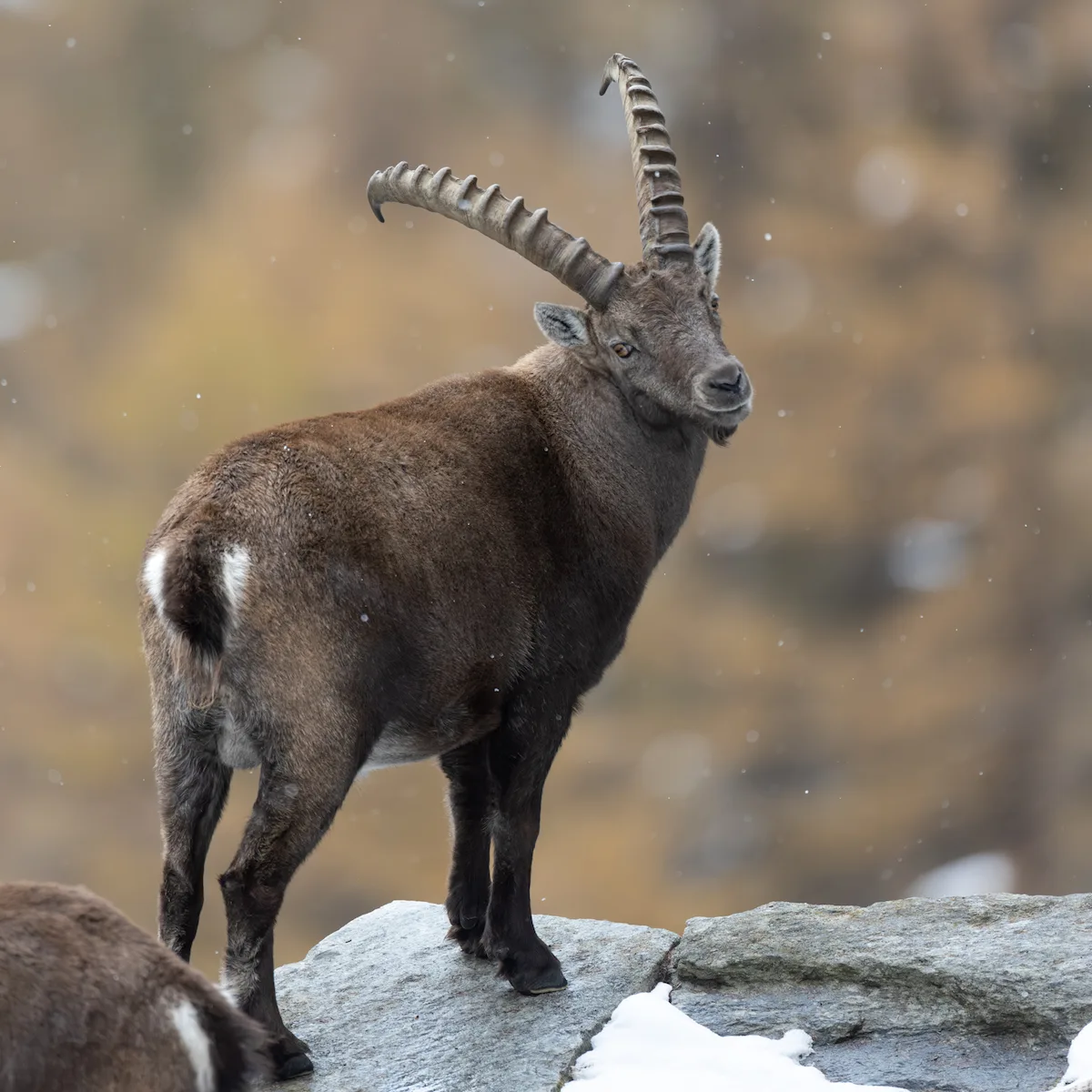I explored Gran Paradiso National Park, a true alpine paradise and Italy’s first national park. As a nature photographer, I have dedicated myself to studying the alpine ibex (Capra ibex), the park’s symbol, to raise awareness about the importance of its conservation and Alpine biodiversity.
Located in the heart of the Italian Alps, Gran Paradiso National Park is a natural gem founded in 1922 to protect the unique flora, fauna, and landscapes of the Alps. This park, spanning majestic peaks and alpine habitats, was originally dedicated to the protection of the alpine ibex, which was at risk of extinction at the time. The hunting reserve once owned by Vittorio Emanuele II was donated by Vittorio Emanuele III, helping to transform this area into a sanctuary for wildlife.
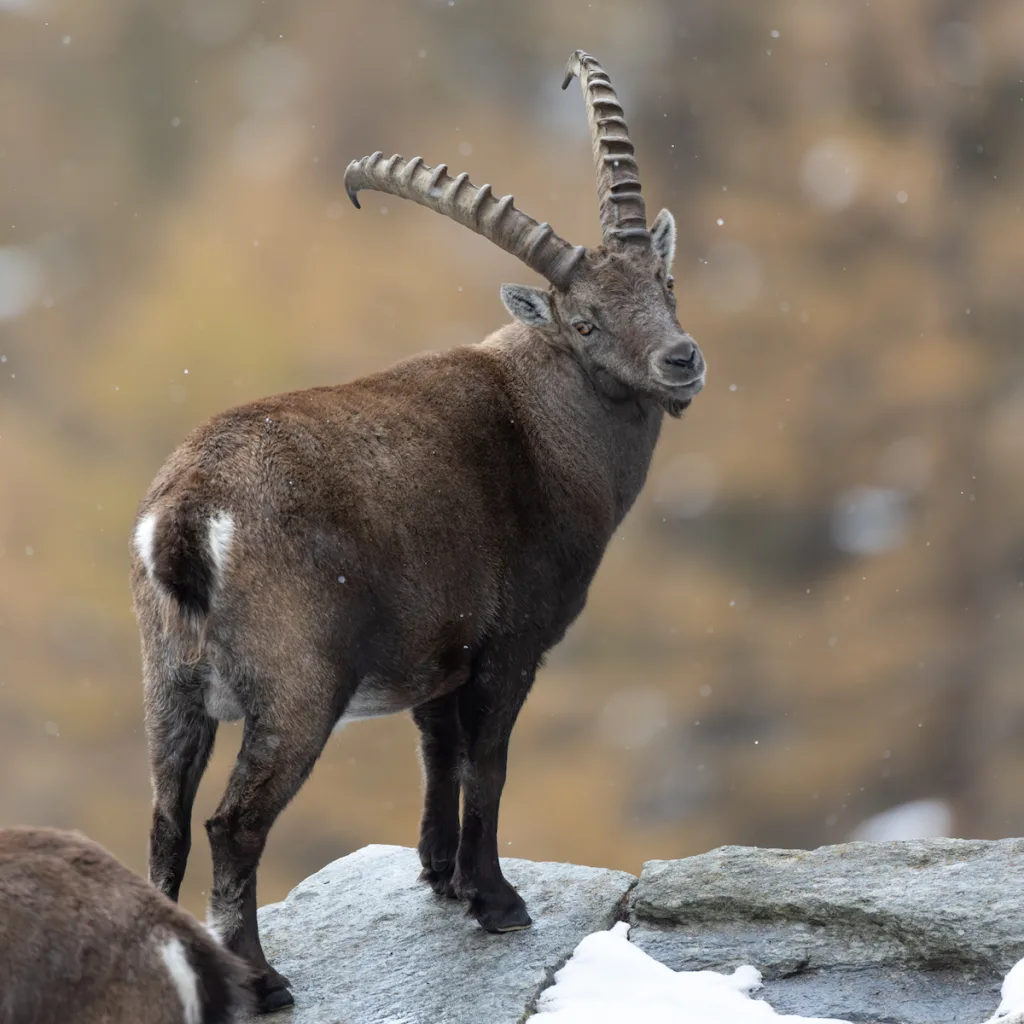
The Alpine ibex (Capra ibex) is an animal that has left significant traces in human history. Depictions of ibexes dating back to prehistoric times testify to their long-standing connection with humans and their role in the natural environment. This animal has demonstrated remarkable resilience, surviving the Ice Age and facing subsequent challenges, including the risk of extinction caused by hunting and human activities.
Characteristics and Curiosities
The Alpine ibex is the soul of Gran Paradiso, a true pioneer of conservation in Italy. By the late 1800s, this species was on the brink of extinction due to uncontrolled hunting, with only 100 individuals remaining. Thanks to the hunting ban imposed by Vittorio Emanuele II, the population began to recover, allowing us to admire this magnificent animal among the Alpine peaks today.
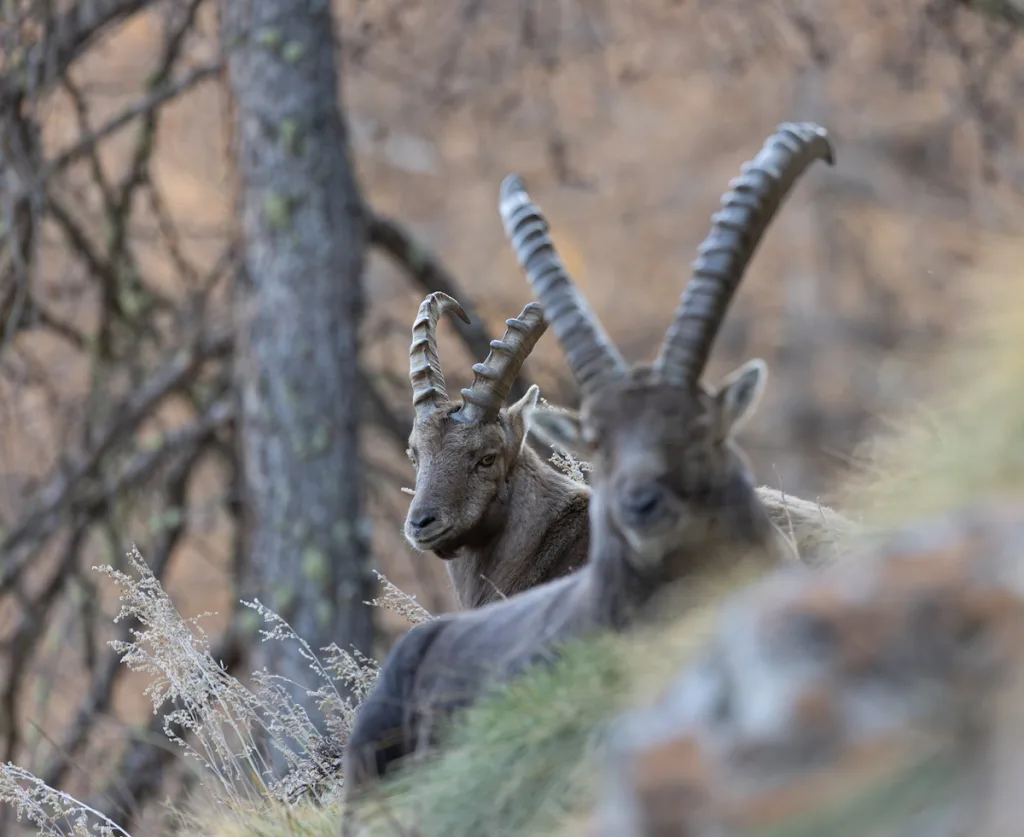
In this species, the difference between the two sexes is evident. The male has a more robust build, weighing between 70 and 100 kg, and features impressive horns that can reach up to one meter in length. These horns, with visible ridges that indicate the animal’s age, are one of its most distinctive features.
Unlike other species such as deer, ibex horns are never shed, making each individual unique and imposing.Unlike the male, the female alpine ibex is smaller in size, weighing between 35 and 60 kg. Her horns, though present, are much shorter than those of the male and rarely exceed 30-35 cm in length. This feature makes her easily distinguishable, along with her lighter fur compared to the male, especially during the summer months.
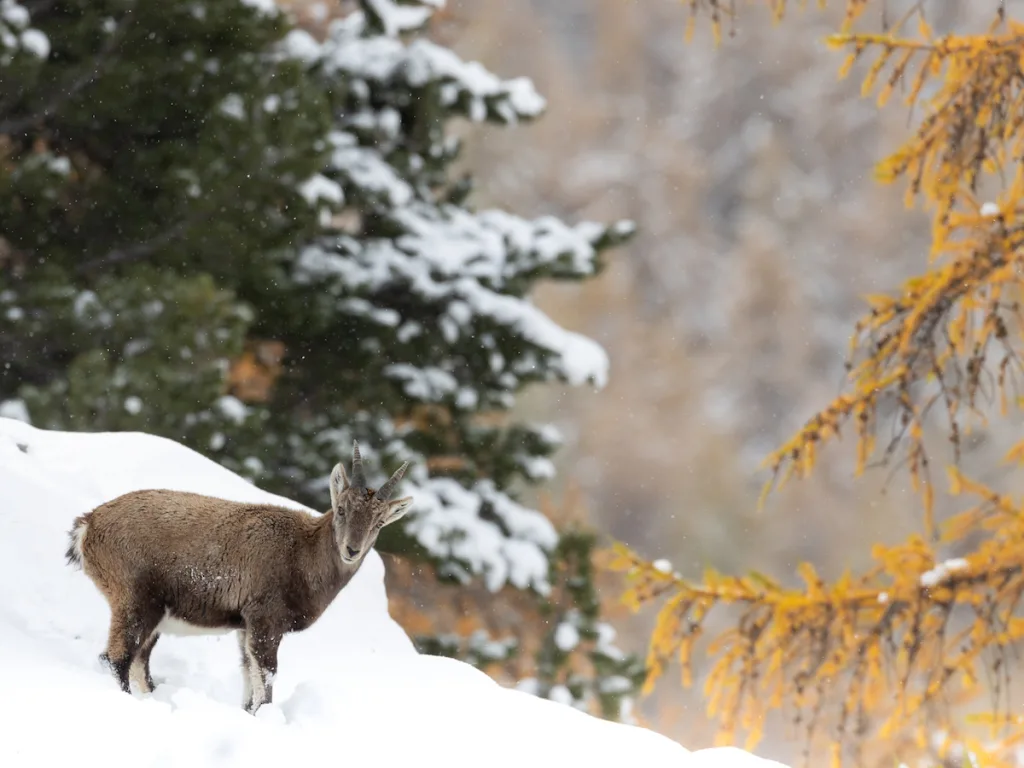
The evident sexual dimorphism between the sexes is an evolutionary adaptation that helps reduce competition for food, as females and males often occupy slightly different areas and exploit different food resources. The female, with her more agile appearance and protective behavior, represents the guardian of the group, ensuring the survival of the young and maintaining the balance of the herd.
Alpine ibex reach physiological maturity at around one and a half years, but the age of the first mating differs between the sexes. Females reproduce for the first time around 4 years of age, while males begin to actively participate in reproduction between 5 and 6 years, when they are strong enough to compete with other males for access to females.
Regarding longevity, life expectancy varies: males typically live between 14 and 16 years, while females, due to less involvement in fights and lower physical stress, can live between 18 and 20 years. These differences are related not only to social roles within the herds but also to the different environmental and behavioral pressures that males and females face in their alpine habitat.The Alpine ibex is a highly social species. For most of the year, males live separately from females and offspring, forming distinct groups. In November, the mating season begins, a period of intense social rituals during which males reunite with females for mating. During this time, males fight each other to establish a hierarchy, using their impressive horns in spectacular displays of strength and endurance.
The behavior of males towards females is characterized by a submissive attitude: males lower their heads, with their horns directed towards their back and their neck pushed forward, a gesture that signals interest without being threatening. Mating occurs between December and January, followed by a gestation period lasting between 20 and 25 weeks, with the young being born around mid-June.
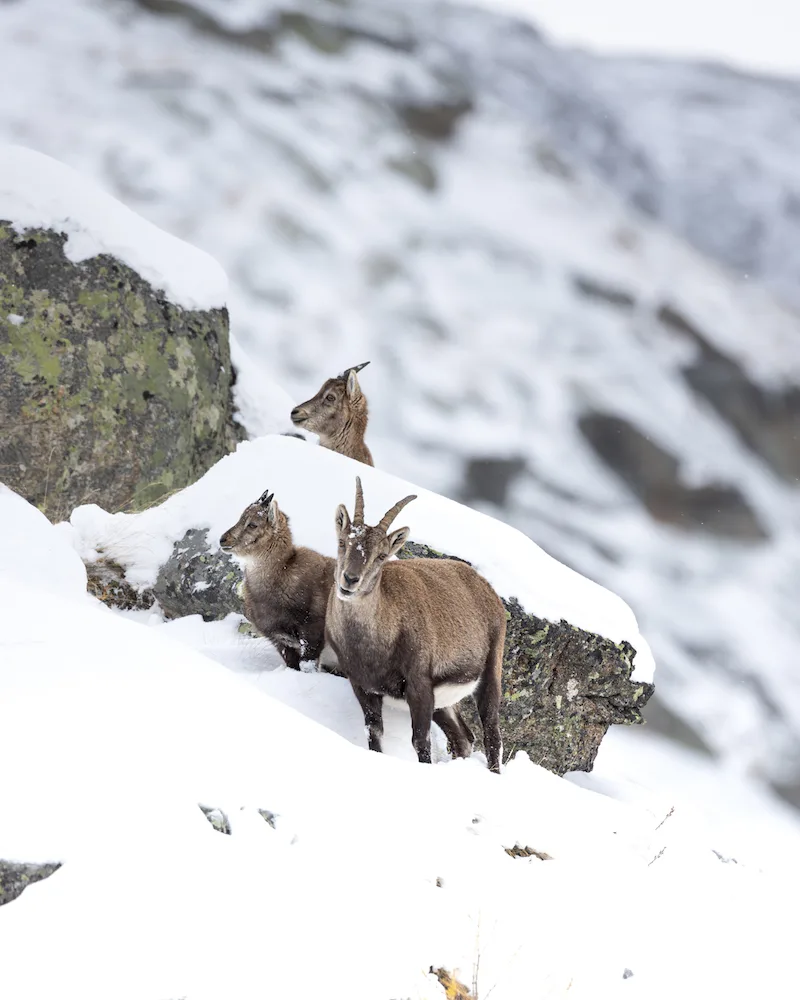
Females give birth in isolated areas, on rocky terrain and at high altitudes, choosing places that offer protection from predators and an environment rich in essential nutrients for the growth of the offspring. These sites, often characterized by alpine meadows inaccessible to predators, provide an ideal refuge for new mothers and their young. Not all females give birth every year, as colonies can be very large, and limited resources impact the reproductive cycle.
The Alpine ibex is well adapted to alpine environments, where it primarily lives in high-altitude meadows and rocky cliffs. During the warmer seasons, the ibex frequents meadows located above 1600 meters in altitude. With the arrival of winter and spring, it descends to lower altitudes, between 800 and 1000 meters, to find food and more favorable climatic conditions.
Its ideal habitat is characterized by alpine environments above the tree line, where the presence of steep rocky cliffs is particularly sought after. These areas provide safe refuges and strategic observation points. The ibex prefers zones with a continental climate and scarce precipitation, as the extreme conditions at high altitudes contribute to its resilience.
Additionally, south-facing slopes are particularly favored, as the snow melts more quickly in these areas, facilitating access to food and reducing movement difficulties. This preference for sunny slopes is a strategic adaptation that optimizes its food resources and contributes to its survival in harsh alpine environments.
The Alpine ibex is highly specialized in consuming concentrated foods, an essential adaptation for its survival in alpine environments. During the summer, when alpine meadows are lush, the ibex primarily feeds on fresh grass. This summer diet provides the energy needed to meet the physical demands of the season.
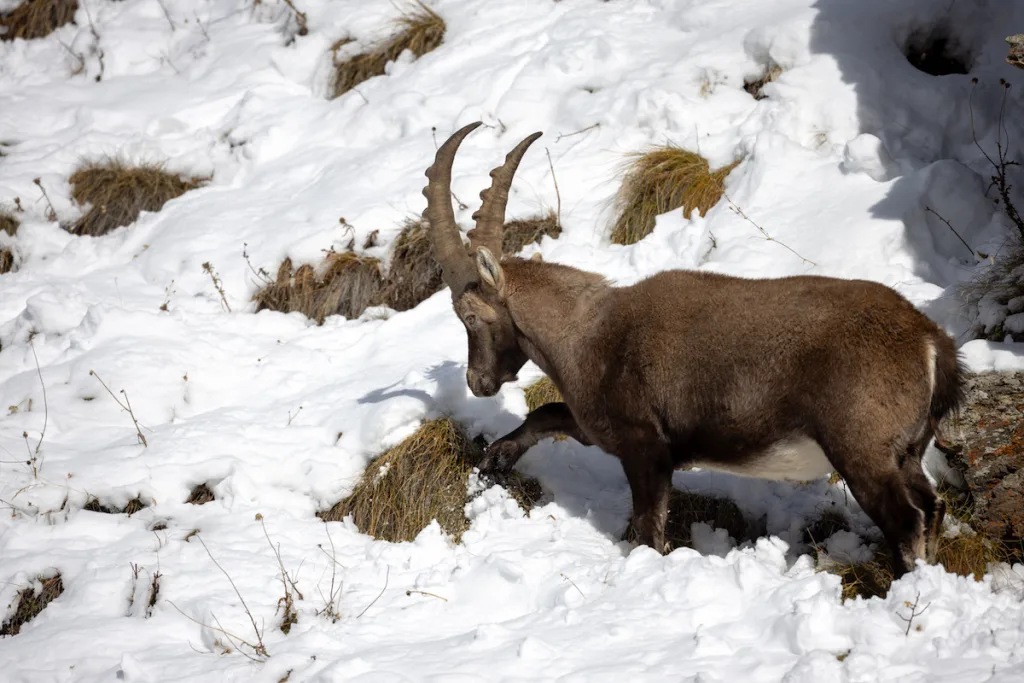
With the arrival of colder seasons, food sources change drastically. In winter and spring, when meadows are covered in snow and vegetation is scarce, the ibex moves to rocky and shrubby areas where it can find rock vegetation and shrubs. The winter and spring diet includes grasses, shoots, lichens, and conifer needles. While these foods are less nutritious than fresh grass, they are adapted to harsher conditions and provide the essential nutrients needed for survival.
The feeding behavior of the ibex demonstrates a remarkable ability to adapt to seasonal changes and available resources, making the most of any type of vegetation it can find in its alpine habitat.
Many other species interact with the alpine ibex and these interactions can influence its conservation and behavior.
Spatial competition between ibexes and domestic sheep or goats has been observed. These competitions can arise over food resources and habitat, especially in shared areas. A serious conservation issue is hybridization with domestic goats. This hybridization can threaten the genetic purity of wild ibex populations, with possible negative effects on their adaptability and survival.
Interactions between ibexes and chamois (Rupicapra rupicapra) vary depending on the area and the density of both species.
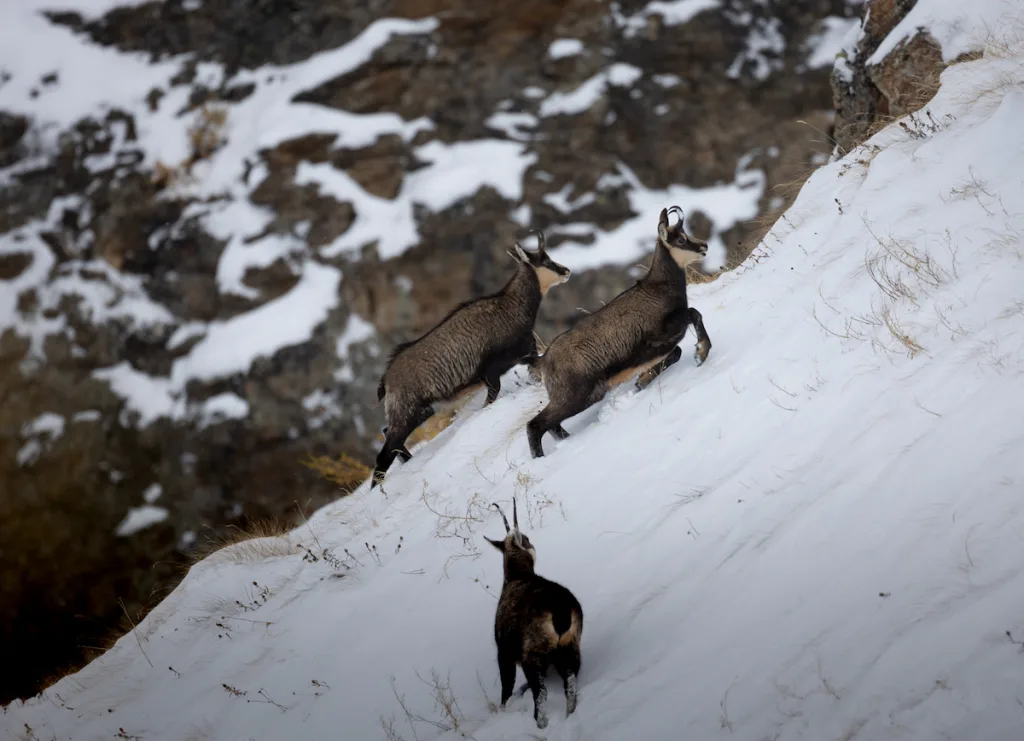
In some areas, they can coexist peacefully, while in others, conflicts may arise over access to resources. These conflicts are influenced by the availability of food and environmental conditions, and can have different effects on the population dynamics of both species.Thanks to its impressive size, the ibex has no natural predators in the Alps, making it one of the dominant species in its habitat. However, the young are vulnerable to predation. Predators such as foxes, eagles, wolves, and lynxes may attack young ibexes, posing a significant threat to their survival. The presence of these predators affects the distribution and behavior of ibexes, especially during the first weeks of the young’s life.
The Alpine ibex is an animal that has left significant traces in human history. Depictions of ibexes dating back to prehistoric times testify to their long-standing connection with humans and their role in the natural environment. This animal has demonstrated remarkable resilience, surviving the Ice Age and facing subsequent challenges, including the risk of extinction caused by hunting and human activities.
Despite a physical structure that may seem clumsy, the ibex is surprisingly agile on exposed and steep terrain. This is possible due to the special shape of its hooves, which provide extraordinary grip on rocky and inclined surfaces.
Unlike the chamois, the ibex does not possess the interdigital fold, a membrane between the hooves that helps chamois move easily on snow. However, the shape of the ibex’s hooves is highly specialized for life on rugged terrain.
The ibex molts only in spring, and during this period, both sexes have similar fur. Females tend to show less contrast in fur color compared to males, reflecting a slight difference in aesthetic characteristics.The horns of the ibex are one of its most distinctive features. Curved and with visible nodules, they grow throughout the animal’s life without ever being shed. These horns, covering two bony protrusions, are used not only for defense and competition but also as an indicator of age.
Each nodule on the horn represents a winter passed, although the growth of the nodules slows with age. The number and arrangement of the nodules can provide valuable insights into the animal’s age.
Challenges and hopes for ibex conservation
Thanks to conservation efforts and reintroduction initiatives, the Alpine ibex has avoided extinction and seen a significant increase in the number of individuals across the Alpine range. These efforts have contributed to the species’ recovery, and it now thrives in various areas of the Alps. Ibex populations are now robust and numerous, thanks to well-managed conservation programs that have restored natural habitats and reduced direct threats such as illegal hunting and habitat loss.
Despite the progress, the species continues to face several challenges. Some pose potential risks to its survival.
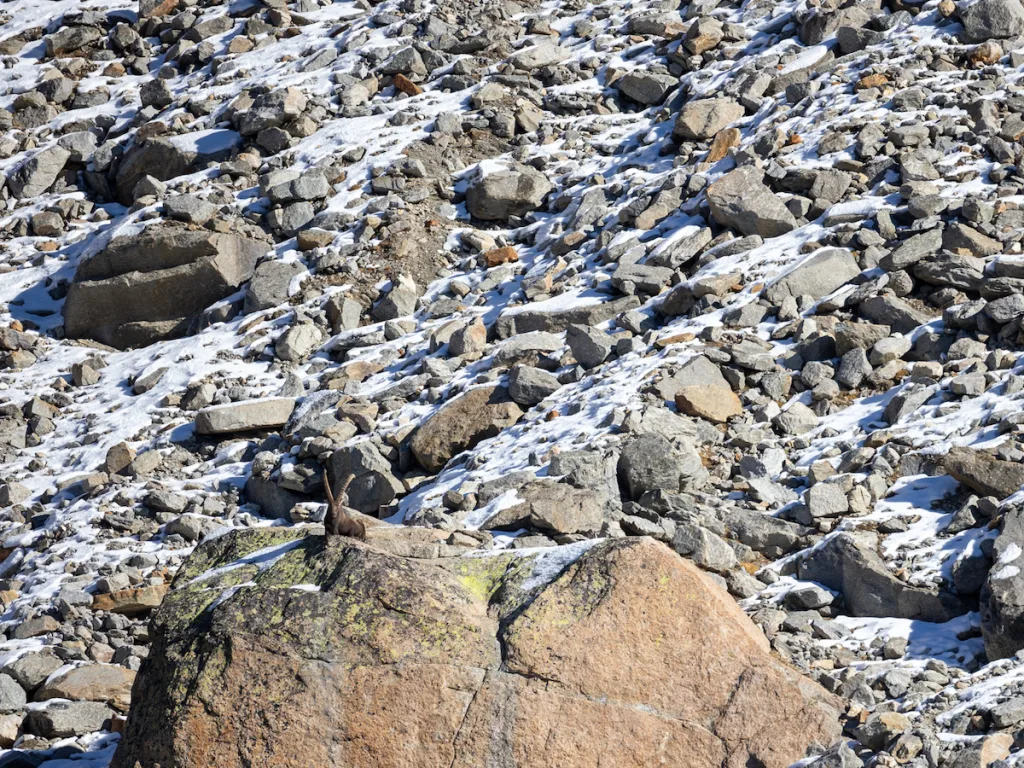
The loss of genetic diversity due to an initially small population base can affect the health and resilience of the species. Inbreeding and low genetic variability can reduce the ibex’s ability to adapt to environmental changes and diseases.
Efforts to preserve and increase genetic variability through targeted management and monitoring programs can help mitigate the risks associated with the loss of genetic diversity. This includes conducting genetic studies to assess the genetic diversity of ibex populations, implementing repopulation and connection programs between isolated populations to increase genetic variability and establishing preventive measures to reduce the risk of epidemics and improve the overall health of the population.
Also,climate change and habitat alterations can affect the availability of food resources and influence the ibex’s migratory and reproductive behaviors. These changes can negatively impact the health and survival of the species.
With rising global temperatures, the ibex may find itself having to seek ever-higher altitudes to find cooler environments. The ibex does not possess a highly efficient thermoregulatory system, meaning that the animal may have difficulty maintaining its body temperature at optimal levels during periods of intense heat. This behavior is particularly relevant during the summer season, when higher temperatures can put the animal’s ability to adapt to the test.
To combat the heat, the ibex tends to move to higher altitudes, where the temperatures are lower and the environment is cooler. This seasonal migration behavior to higher elevations represents a strategy to maintain body temperature within safe limits and reduce thermal stress.
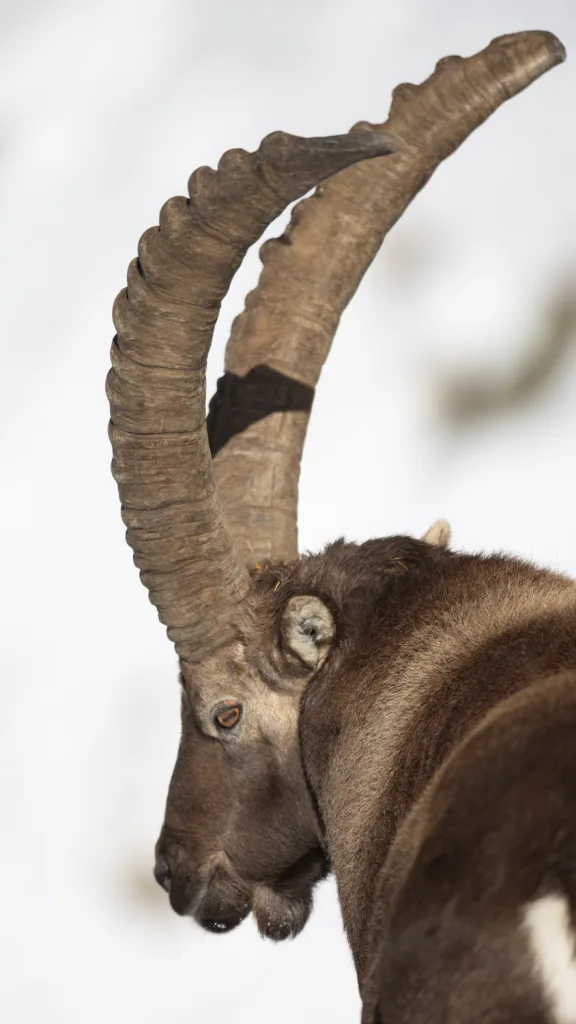
Competition with other species, both wild and domestic, as well as the risk of hybridization, can pose threats to genetic purity and population stability of the ibex.
To address these challenges, it is essential to continue monitoring ibex populations and implement adaptive conservation strategies. Collaboration between biologists, ecologists, and local communities is crucial to ensure the long-term protection of the species and mitigate future risks.
For instance, to address the impact of climate change, it is essential to adopt conservation strategies that include regular monitoring to observe changes in habitat and ibex population dynamics, measures to protect and preserve high-altitude habitats and to invest in research to better understand how climate change affects the ibex and develop targeted adaptation plans.
The ibex shows a low tendency for colonization, meaning it is reluctant to settle in new areas outside its traditional habitat. This characteristic presents a significant challenge for the species’ conservation and reintroduction efforts. Despite efforts to expand its populations, colonizing new areas can be difficult.
To overcome the difficulties associated with the low tendency for colonization, it is essential to persevere in reintroducing the ibex to new areas. This process involves identifying habitats that offer favorable ecological and environmental conditions for the survival and reproduction of the ibex, closely monitoring the new colonies to ensure the animals adapt well to the environment and the populations grow sustainably and addressing potential threats, such as competition with other species or habitat loss, that could negatively impact the success of the reintroduction.
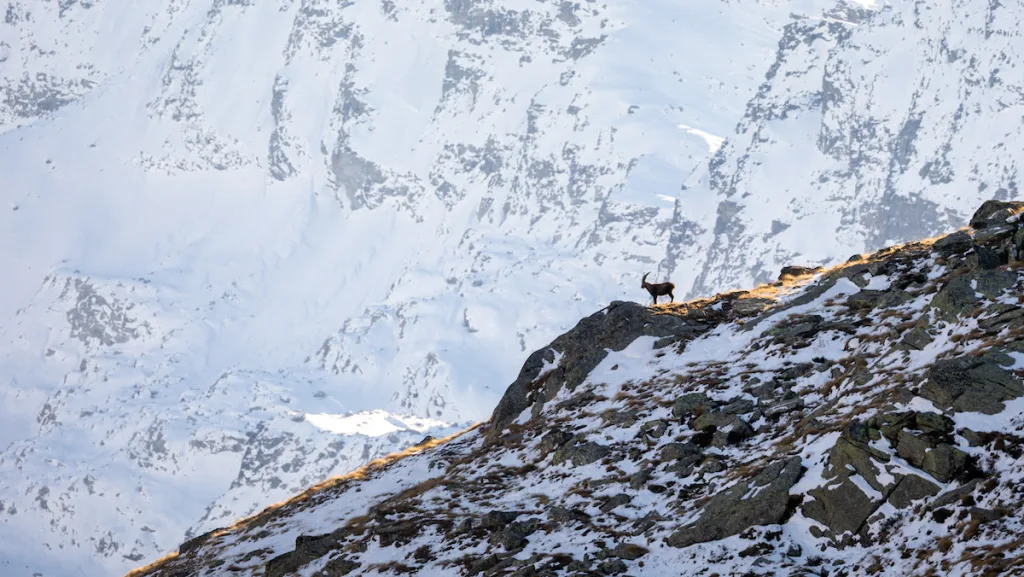
The ultimate goal is the continuous formation of new ibex colonies in suitable areas. This helps to increase genetic variability and ensure that the ibex can adapt to environmental and climatic changes by finding new habitats that can support its ecological needs. It’s also important because it creates a network of populations that can interact and support each other, contributing to the long-term stability of the species.
To address the challenges of low colonization tendency and ensure the success of reintroduction, it is crucial to collaborate with biologists, ecologists, and conservation organizations to develop and implement effective strategies; increase public awareness regarding the conservation of the ibex and the importance of preserving its natural habitats and adopt innovative and adaptive approaches based on scientific data to optimize reintroduction and population management efforts.
The ibex faces significant challenges for its survival. Its conservation requires ongoing efforts to overcome numerous environmental threats and preserve the genetic diversity of the species. From epidemics that decimate populations to limited thermoregulation abilities that make the ibex vulnerable to climate change, every aspect of its life is interconnected with its vulnerability.
Reintroduction into new areas and the creation of new colonies are essential for ensuring the survival of the ibex. These efforts help to provide new safe and suitable areas for the population, increase genetic variability and improve the resilience of the species and ensure that populations can cope with future environmental challenges, namely climate change.
A sincere thank you goes to all those who tirelessly work to safeguard this extraordinary mountain creature. Their dedication allows people like me to admire and appreciate the natural wonders of the Alps.
Discover Cristiano Garola’s nature portfolio here.







